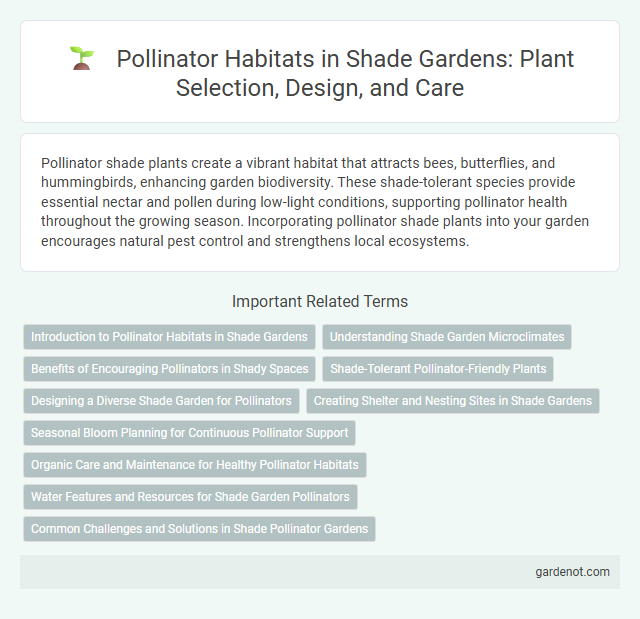Pollinator shade plants create a vibrant habitat that attracts bees, butterflies, and hummingbirds, enhancing garden biodiversity. These shade-tolerant species provide essential nectar and pollen during low-light conditions, supporting pollinator health throughout the growing season. Incorporating pollinator shade plants into your garden encourages natural pest control and strengthens local ecosystems.
Introduction to Pollinator Habitats in Shade Gardens
Pollinator shade gardens create essential habitats that support bees, butterflies, and other beneficial insects by providing shelter and food sources in low-light environments. Plants such as hostas, ferns, and astilbes thrive in shaded areas while attracting pollinators with their nectar and pollen. Establishing diverse shade-tolerant flowering species fosters biodiversity and helps maintain healthy pollinator populations critical for ecosystem balance.
Understanding Shade Garden Microclimates
Shade garden microclimates create unique environments that support diverse pollinator species such as bumblebees, butterflies, and hummingbirds. Understanding factors like light levels, soil moisture, and temperature variations helps optimize plant selection to attract and sustain these vital pollinators. Incorporating native shade-loving plants with nectar and pollen-rich flowers enhances habitat quality and promotes pollinator activity in shaded garden areas.
Benefits of Encouraging Pollinators in Shady Spaces
Encouraging pollinators in shade gardens enhances biodiversity by attracting bees, butterflies, and other beneficial insects that thrive in low-light environments. These pollinators improve plant health and fruit production by facilitating effective pollination of shade-tolerant plants such as impatiens and hostas. Integrating pollinator-friendly plants in shaded areas supports ecosystem balance and promotes a vibrant, sustainable garden habitat.
Shade-Tolerant Pollinator-Friendly Plants
Shade-tolerant pollinator-friendly plants such as hostas, astilbes, and hellebores provide vital nectar and pollen sources for bees, butterflies, and hummingbirds in low-light garden areas. These plants thrive under dense tree canopies or shaded borders, creating a lush habitat that supports pollinator biodiversity. Incorporating native species like foamflower and wild ginger enhances ecological resilience while ensuring continuous bloom periods in shaded environments.
Designing a Diverse Shade Garden for Pollinators
Designing a diverse shade garden for pollinators involves selecting native shade-tolerant plants like Impatiens, Trilliums, and Coral Bells to provide nectar and habitat throughout the growing season. Incorporating a variety of flowering plants with staggered bloom times supports bees, butterflies, and hummingbirds by ensuring continuous food sources. Adding host plants such as violets and goldenrod enhances butterfly populations, while maintaining soil moisture and rich organic matter fosters a healthy microhabitat for pollinator activity.
Creating Shelter and Nesting Sites in Shade Gardens
Pollinator shade gardens provide essential shelter and nesting habitats for species like bumblebees, butterflies, and solitary bees, ensuring their survival and promoting biodiversity. Incorporating native shade-tolerant plants with varied root structures supports ground-nesting pollinators, while adding brush piles, dead wood, and hollow stems creates ideal nesting sites. These strategic habitat enhancements increase pollinator activity and contribute to healthier, more resilient shade garden ecosystems.
Seasonal Bloom Planning for Continuous Pollinator Support
Seasonal bloom planning in a pollinator shade garden ensures a continuous supply of nectar and pollen from early spring to late fall, maximizing habitat sustainability. Incorporating diverse native shade-tolerant perennials such as foamflower, bleeding heart, and wild ginger caters to different pollinator species throughout various seasons. Strategic layering of bloom times supports consistent pollinator activity, enhancing biodiversity and ecosystem resilience in shaded environments.
Organic Care and Maintenance for Healthy Pollinator Habitats
Organic care and maintenance of pollinator shade gardens prioritize natural methods to nurture healthy ecosystems that support bees, butterflies, and other pollinators. Utilizing compost, mulch, and organic pest control ensures soil vitality and reduces harmful chemical exposure, promoting thriving pollinator habitats. Regular monitoring and selective pruning foster plant diversity and bloom succession, enhancing habitat quality and food availability for pollinators throughout the season.
Water Features and Resources for Shade Garden Pollinators
Water features such as shallow birdbaths, small ponds, and dripping fountains provide essential hydration for shade garden pollinators like bees and butterflies. Incorporating native aquatic plants and creating damp, sheltered areas enhance habitat quality and attract a diverse range of pollinating species. Providing natural water sources combined with ample shade-adapted flowering plants supports pollinator health and promotes a vibrant, sustainable garden ecosystem.
Common Challenges and Solutions in Shade Pollinator Gardens
Pollinator shade gardens often face challenges such as limited sunlight, which reduces nectar production and hinders pollinator activity. Selecting shade-tolerant flowering plants like columbine, hellebores, and foamflower provides vital nectar and pollen sources for bees, butterflies, and hummingbirds. Incorporating native plants and maintaining moist, well-drained soil improves habitat quality and supports diverse pollinator populations in shaded environments.
Pollinator shade Infographic

 gardenot.com
gardenot.com